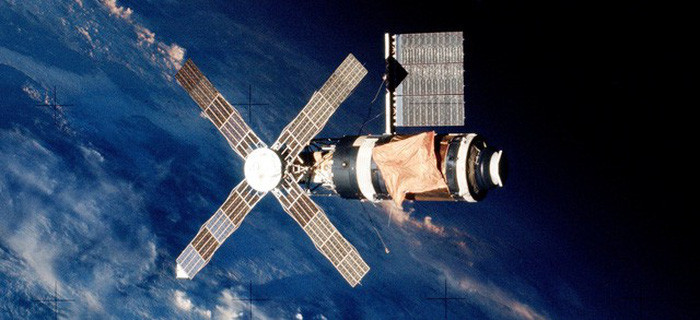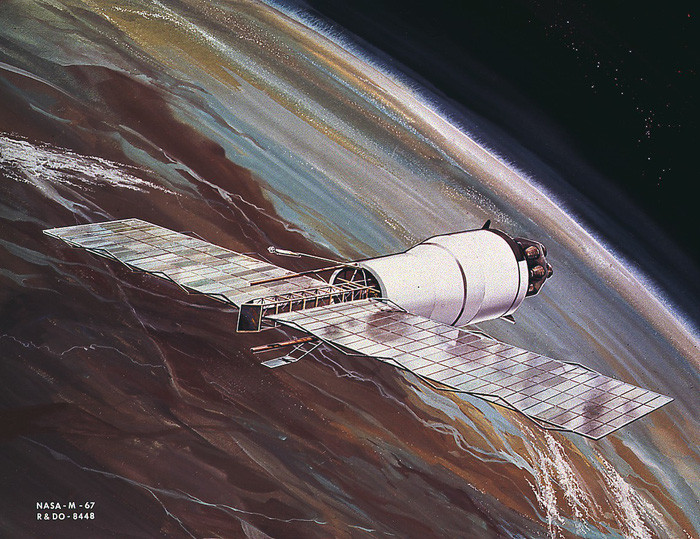The fall of satellites made the Earth
In March this year, China's will fall to Earth but do not know exactly where it falls. However, this is not the first time the world has witnessed a fall in satellites.

Skylab Space Station - (Photo: NASA).
Skylab was the first US space station launched into space on May 14, 1973 and assigned to carry out missions for more than 50 years to return.
However, only in 1979, Skylab had to return to earth.
Several hours before the fall, NASA scientists tried to adjust Skylab's flight direction to avoid falling into the residential area.
They calculated Skylab would fall south of Cape Town, South Africa, but its fragments fell to the eastern part of Perth, Western Australia and the Indian Ocean region.
Luckily there were no casualties. However, the Australian government now demanded US compensation . $ 400 to collect the debris.
Pegasus 2 satellite

NASA's Pegasus 2 - (Photo: NASA).
The satellite was put on orbit by NASA in 1965, weighing 11.6 tons and is part of a program to study the existence of microscopic asteroids flying around Earth's orbit.
This is the second of three satellites to take charge of this NASA program.
Pegasus 2 collected data and sent it home within 3 years, then stopped working but still maintained the trajectory until 11 years later and on November 3, 1979 returned to Earth.
Its fragments are recorded plunging into the middle of the Atlantic Ocean.
Kosmos satellite 954

Nuclear radiation hazard from the accident of Kosmos 954.
Weighing 3.8 tons, the satellite launched in 1977 is part of the US nuclear submarine monitoring program.
What is special is that without the solar panels, Kosmos 954 has a nuclear reactor system that provides fuel for the operation. This is a great threat when falling to Earth.
On January 24, 1978, Kosmos 954 returned to Earth's atmosphere towards northeastern Canada.
The Soviet government at the time confirmed that the satellite had been completely ignited before falling to the ground, but soon fragments were found on Canadian territory within a distance of 600km from the Big Slave Lake and Lake Baker.
Radioactive debris spread on a large area, causing the Canadian government to ask the Soviet Union to pay $ 6 million to clean up and overcome the consequences, but the USSR only agreed to give $ 3 million.
Kosmos 954 is not the first satellite to fall in this Soviet program. Earlier, a satellite launched in 1973 fell into the Pacific region, while Kosmos 1402 also fell to the South Atlantic in 1983.
Salyut 7 satellite

Poster documentary about Salyut 7.
Salyut 7 was introduced into the space in 1982 by the Soviet Union in the program of building 9 space ports for other satellites.
Salyut 7 is about 16m long and 4.15m wide at its widest point. The total mass of this satellite is estimated at 22 tons.
In 9 years of operation, there are 6 different crews on duty outside the space on Salyut 7.
On February 11, 1985, Salyut 7 suddenly lost signal to the mainland and the systems on the station stopped working. The Soviet Union then sent a task force to repair the station and the operation station returned to normal.
By the end of the 1980s, Salyut 7's trajectory began to take place. Finally, on February 7, 1991, the station lost control and began to fall to Earth.
Its fragments were determined to fall to Argentina, in which several pieces of badly burned equipment were discovered in the town of Capitan Bermudez but there were no casualties.
Rosat satellite

Rosat satellite carries a large universe - (Photo: DLR.de).
Rosat was launched into orbit in June 1990 carrying a giant telescope, the joint work of German, American and British scientists.
The telescope's mission is to examine the space with X-rays while recording images of all objects in the space that emit this radiation.
Although Rosat's assignment was only 18 months, the time of Rosat's operation was up to 9 years.
Upon returning to Earth, scientists calculated its mass up to 2,400kg could not burn out in the atmosphere. Debris can reach up to 400 more likely to endanger people on the ground.
On October 23, 2011, scientists recorded Rosat returning to Earth in the sky in the Bay of Bengal, India.
However, it has not been confirmed whether the fragments will reach Earth.
UARS satellite

NASA UARS satellite - (Photo: NASA).
The satellite tracks the 6.5-ton atmospheric floor with a length of 10.7m, which is 4.5m wide and is put on orbit by NASA's Discovery shuttle in September 1991.
The mission of this 750 million-dollar satellite is to study the Earth's atmosphere in 14 years to December 2005, ceasing operations due to running out of fuel.
NASA judges that UARS will break into more than 100 pieces during the fall, most of the debris will burn out due to friction with the air.
More than 20 remaining pieces will fall across an area of 1,000-2,000km long and 400-500km wide, but will not fall in North America.
Scientists worry that UARS will fall into the mainland and densely populated areas, in which Vietnam is also likely to be affected. In the end, it fell into the remote part of the Pacific.
However UARS is nothing compared to the uncontrolled Skylab space station because Skylab is 15 times heavier than UARS.
Space shuttle Columbia

7 members of the ill-fated flight crew during Columbia's 28th flight - (Photo: NASA).
Space Shuttle Columbia was the first ship in NASA's space shuttle fleet to be able to fly into space and was first launched in 1981.
On February 1, 2003, the Columbia ship exploded during the 28th flight, killing seven crew members.
The survey results show that the damage on the left wing of Columbia's left wing heat is the cause of a tragic accident.
The piece of foam insulating from the fuel tank that fell off during the take-off process punctured a large hole in the left wing of the ship, causing hot air to flow into the process.
Fragments of spacecraft weighing more than 100 tons fall scattered in northeastern Texas, USA.
- Old satellites race each other to fall to Earth
- Accurate fall point of German satellites
- GOCE satellite is about to fall to earth
- The satellite measures the attraction of the Earth to the end of fuel
- American artificial satellites fall on the following weekend
- Vietnam satellite will enter space in 2018
- The F-1 satellite has not yet signaled
- Can the German satellite fall to Vietnam?
- Russia destroyed the military satellite
- Russian satellites are about to fall to Earth
- Satellite weighs 1 ton preparing to fall to Earth
- Argentina successfully launched the second self-made geostationary satellite
 Van Allen's belt and evidence that the Apollo 11 mission to the Moon was myth
Van Allen's belt and evidence that the Apollo 11 mission to the Moon was myth The levels of civilization in the universe (Kardashev scale)
The levels of civilization in the universe (Kardashev scale) Today Mars, the sun and the Earth are aligned
Today Mars, the sun and the Earth are aligned The Amazon owner announced a secret plan to build a space base for thousands of people
The Amazon owner announced a secret plan to build a space base for thousands of people Artificial satellite missing for 40 years suddenly returns, leaving scientists bewildered
Artificial satellite missing for 40 years suddenly returns, leaving scientists bewildered  What exactly is the space signal detected by Tesla?
What exactly is the space signal detected by Tesla?  Satellite debris poses a serious threat to the atmosphere
Satellite debris poses a serious threat to the atmosphere  Declassified spy satellite, 1,400-year-old ghost town appears
Declassified spy satellite, 1,400-year-old ghost town appears  Britain's oldest satellite mysteriously moves
Britain's oldest satellite mysteriously moves  Boeing satellite explodes in space
Boeing satellite explodes in space 